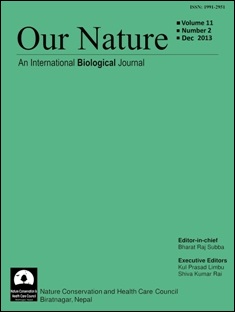Conservation of Critically Endangered Olive Barb Puntius sarana (Hamilton, 1822) through Artificial Propagation
DOI:
https://doi.org/10.3126/on.v11i2.9534Keywords:
Cyprinidae, artificial propagation, pituitary gland, breeding, fertilization, hatchingAbstract
The Olive barb Puntius sarana (Hamilton, 1822) is a member of the family Cyprinidae and its conservational status has been referred as critically endangered in Bangladesh and vulnerable in India. An experiment on artificial propagation of the critically endangered fish P. sarana was carried out to determine the suitable dose of pituitary gland (PG) hormone as well as to determine the effective breeding season for the conservation of this critically endangered fish species. Three breeding trials (April 2010, June 2010 and July 2010) have been taken into consideration with PG doses in three different treatments (4.5, 5.5, 6.5 mg/kg body weight, respectively) having three replications of each. Brood fishes were collected from the Kangsha River (Netrokona) and reared in the experimental ponds, providing special diet upto their maturation. A total of 18 broods (9 female and 9 male) were selected for induced breeding in each trial. To observe the effective dose for induced breeding, the females were first injected at the rate of 4.5, 5.5 and 6.5 mg PG/kg body weight in T1, T2 and T3, respectively in each trial. On the other hand, the males were administrated at the rate of 2 mg PG/kg body weight. The breeding performance in terms of ovulation, fertilization and hatching rate were studied. Induced breeding, in trial-2 obtained the better result in terms of ovulation, fertilization and hatching rate compared to other two trials. In trial-2 among the treatments, T2 with doses of 5.5 mg/kg body weight showed better result than other two treatments where 4.5 and 6.5 mg/kg body weight PG doses were used in T1 and T3, respectively. The findings of the present study can be used in induced breeding of P. sarana for the development of hatchery propagation as well as to conserve this valuable critically endangered species.
DOI: http://dx.doi.org/10.3126/on.v11i2.9534
Our Nature 2013, 11(2): 96-104
Downloads
Downloads
Published
How to Cite
Issue
Section
License
This license enables reusers to distribute, remix, adapt, and build upon the material in any medium or format for noncommercial purposes only, and only so long as attribution is given to the creator.




